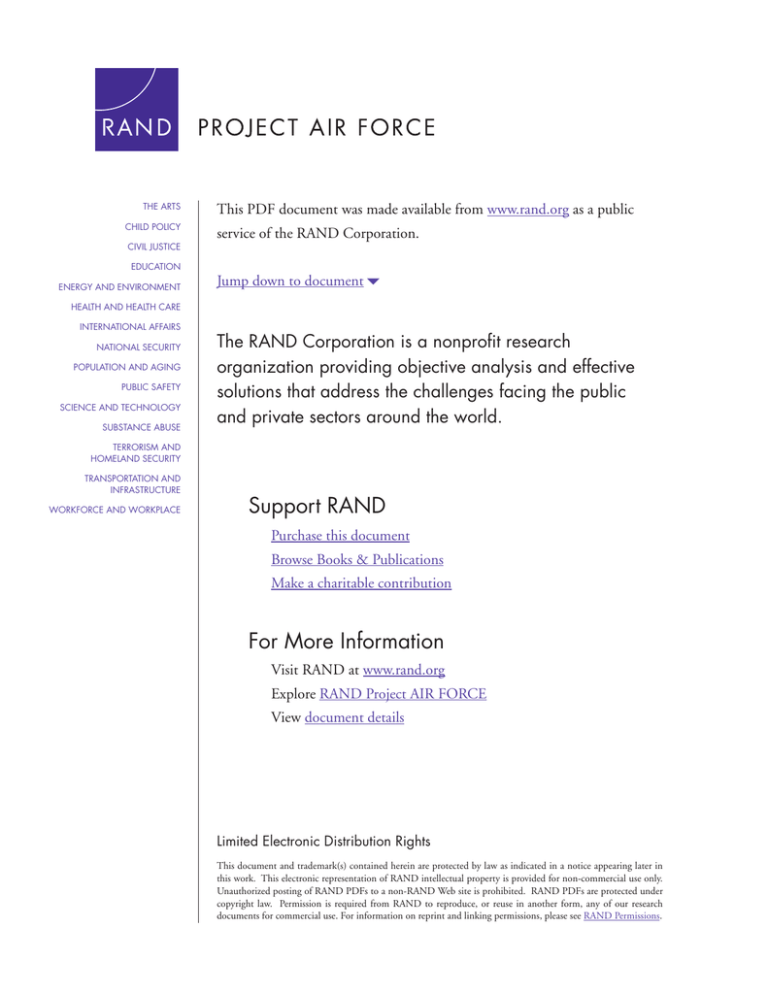
THE ARTS
CHILD POLICY
CIVIL JUSTICE
EDUCATION
ENERGY AND ENVIRONMENT
This PDF document was made available from www.rand.org as a public
service of the RAND Corporation.
Jump down to document6
HEALTH AND HEALTH CARE
INTERNATIONAL AFFAIRS
NATIONAL SECURITY
POPULATION AND AGING
PUBLIC SAFETY
SCIENCE AND TECHNOLOGY
SUBSTANCE ABUSE
The RAND Corporation is a nonprofit research
organization providing objective analysis and effective
solutions that address the challenges facing the public
and private sectors around the world.
TERRORISM AND
HOMELAND SECURITY
TRANSPORTATION AND
INFRASTRUCTURE
WORKFORCE AND WORKPLACE
Support RAND
Purchase this document
Browse Books & Publications
Make a charitable contribution
For More Information
Visit RAND at www.rand.org
Explore RAND Project AIR FORCE
View document details
Limited Electronic Distribution Rights
This document and trademark(s) contained herein are protected by law as indicated in a notice appearing later in
this work. This electronic representation of RAND intellectual property is provided for non-commercial use only.
Unauthorized posting of RAND PDFs to a non-RAND Web site is prohibited. RAND PDFs are protected under
copyright law. Permission is required from RAND to reproduce, or reuse in another form, any of our research
documents for commercial use. For information on reprint and linking permissions, please see RAND Permissions.
This product is part of the RAND Corporation technical report series. Reports may
include research findings on a specific topic that is limited in scope; present discussions of the methodology employed in research; provide literature reviews, survey
instruments, modeling exercises, guidelines for practitioners and research professionals, and supporting documentation; or deliver preliminary findings. All RAND
reports undergo rigorous peer review to ensure that they meet high standards for research quality and objectivity.
Opportunities for
Systems Engineering to
Contribute to Durability
and Damage Tolerance
of Hybrid Structures
for Airframes
Jean R. Gebman
Prepared for the United States Air Force
Approved for public release; distribution unlimited
PROJECT AIR FORCE
The research described in this report was sponsored by the United States Air Force under
Contract FA7014-06-C-0001. Further information may be obtained from the Strategic
Planning Division, Directorate of Plans, Hq USAF.
Library of Congress Cataloging-in-Publication Data
Gebman, J. R.
Opportunities for systems engineering to contribute to durability and damage tolerance of hybrid structures
for airframes / Jean R. Gebman.
p. cm.
Includes bibliographical references.
ISBN 978-0-8330-4202-6 (pbk. : alk. paper)
1. Airframes—Design and construction. 2. Structural dynamics. 3. Airframes—Materials. 4. Composite
materials. 5. Airplanes, Military—Design and construction. 6. Fault tolerance (Engineering) 7. Systems
engineering. I. Title.
TL671.6.G43 2007
629.134'31—dc22
2007039674
The RAND Corporation is a nonprofit research organization providing objective analysis
and effective solutions that address the challenges facing the public and private sectors
around the world. RAND’s publications do not necessarily reflect the opinions of its
research clients and sponsors.
R® is a registered trademark.
© Copyright 2008 RAND Corporation
All rights reserved. No part of this book may be reproduced in any form by any electronic or
mechanical means (including photocopying, recording, or information storage and retrieval)
without permission in writing from RAND.
Published 2008 by the RAND Corporation
1776 Main Street, P.O. Box 2138, Santa Monica, CA 90407-2138
1200 South Hayes Street, Arlington, VA 22202-5050
4570 Fifth Avenue, Suite 600, Pittsburgh, PA 15213-2665
RAND URL: http://www.rand.org
To order RAND documents or to obtain additional information, contact
Distribution Services: Telephone: (310) 451-7002;
Fax: (310) 451-6915; Email: order@rand.org
Summary
Although a general approach to fielding durable, damage-tolerant structures has been well
defined for several decades for metal airframes, the rising use of other materials and the growing role of hybrid structures in airframes are creating a need to tailor the general approach to
deal with new damage mechanisms. This has created opportunities for systems engineering to
contribute to the tailoring and implementation of the general approach to hybrid structures for
airframes. Such implementation can help ensure that an appropriate sequence of investments
is made in time to support key decisions related to the research, design, development, test,
manufacturing, and sustainment of airframes that have hybrid structures. As industry and
operators are tailoring the implementation of the general approach, this may be a good time to
pause and consider how well materials engineers, structural engineers, and systems engineers
are performing as a team in assuring the durability and damage tolerance of hybrid structures
for airframes over their life cycles.
To support such considerations, this report starts by summarizing the Air Force’s general
approach to developing and sustaining durable, damage-tolerant structures for airframes (see
pp. 15–20). Although the details of the approach evolved during an era of metal airframes, its
general framework is broadly applicable to airframes in general. Because hybrid structures that
have multiple classes of materials are accounting for a growing proportion of the structural
assemblies in modern airframes and because they introduce new challenges for durability and
damage tolerance, this report explores how systems-engineering efforts may help tailor implementation of the general approach to hybrid structures for airframes.
The report also identifies technical and programmatic considerations that need to be
addressed by a systems-engineering approach (see pp. 21–24). Next, the report identifies opportunities for materials engineers and structural engineers to collaborate with systems engineers
in ensuring the durability and damage tolerance of hybrid structures in airframes (see pp. 25–
27). Finally, it describes a candidate framework for facilitating such collaboration (see pp. 29–
34). Such a framework may provide a useful basis for considering and continuously improving
the team performance of the materials engineers, structural engineers, and systems engineers
who are responsible for ensuring the durability and damage tolerance of hybrid structures over
an airframe’s life cycle.
xi






